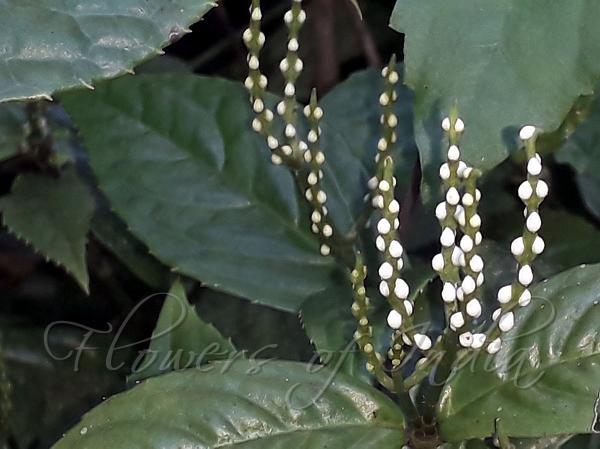|
| Tall Chloranthus |
|

|

| File size | 447273 |
| Original date | 11/16/19 3:24 PM |
| Resolution | 2048 x 1536 |
| Flash | Flash fired |
| Focal length | 3.6mm |
| Exposure time | 1/100s |
| Aperture | 1.9 |
| Focus Distance | |
| Metering Mode | Center weighted average |
| Camera make | samsung |
| Camera model | SM-J400F |
| Sensor type |
|
|
|
|
Photo: |
Botanical name: Chloranthus elatior Family: Chloranthaceae (Chloranthus family)
Synonyms: Chloranthus erectus, Chloranthus officinalis, Chloranthus salicifolius
Synonyms: Chloranthus erectus, Chloranthus officinalis, Chloranthus salicifolius
Tall Chloranthus is a subshrub up to 2 m tall. Stems
are round in cross-section, hairless. Leaves are opposite; leaf-stalk
5-13 mm; leaf blade broadly elliptic or obovate to long obovate or
inverted-lanceshaped, 10-20 x 4-8 cm, rigidly papery, glandular,
hairless, base wedge-shaped, margin sawtoothed, tip gradually narrowed
to with a tail; lateral veins 5-9 pairs. Flowers are borne in spikes at
branch-ends, dichotomously or racemosely branched, rearranged in
panicles, long stalked; bracts triangular or ovate. Flowers are white,
small, stamens 3; connectives confluent and ovoid, not elongate, apical
part 3-lobed. Ovary is ovoid. Fruits are green when young, white at
maturity, obovoid, about 5 mm. Tall Chloranthus is found in the
Himalayas to S China, Indochina, Philippines, Indonesia to New Guinea,
at altitudes of 100-2000 m. Flowering: April-June.
Medicinal uses: Leaves and roots are used as
aphrodesiac, especially for women. In India the juice of the boiled
branches is used as a contraceptive, and the root and the bark acts as
a antispasmodic during childbirth. The leaf extract is considered a
cure for venereal diseases. The plant is also used to treat fever, and
pain killer.
Leaves and roots are used as
aphrodesiac, especially for women. In India the juice of the boiled
branches is used as a contraceptive, and the root and the bark acts as
a antispasmodic during childbirth. The leaf extract is considered a
cure for venereal diseases. The plant is also used to treat fever, and
pain killer.
Medicinal uses:
 Leaves and roots are used as
aphrodesiac, especially for women. In India the juice of the boiled
branches is used as a contraceptive, and the root and the bark acts as
a antispasmodic during childbirth. The leaf extract is considered a
cure for venereal diseases. The plant is also used to treat fever, and
pain killer.
Leaves and roots are used as
aphrodesiac, especially for women. In India the juice of the boiled
branches is used as a contraceptive, and the root and the bark acts as
a antispasmodic during childbirth. The leaf extract is considered a
cure for venereal diseases. The plant is also used to treat fever, and
pain killer. | Identification credit: Nidhan Singh | Photographed in Pasighat, Arunachal Pradesh & Biswanath Chariali, Assam. |
• Is this flower misidentified? If yes,